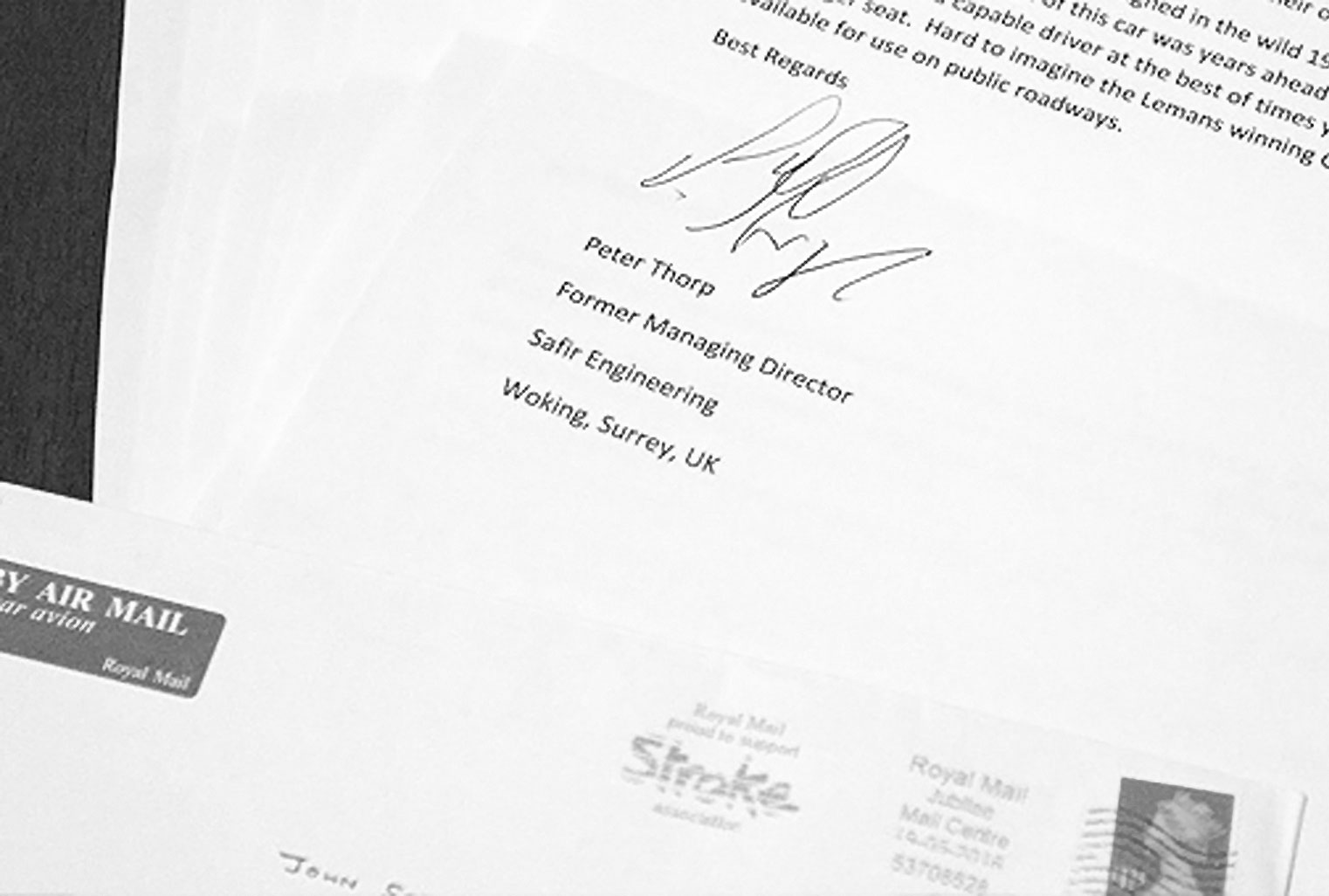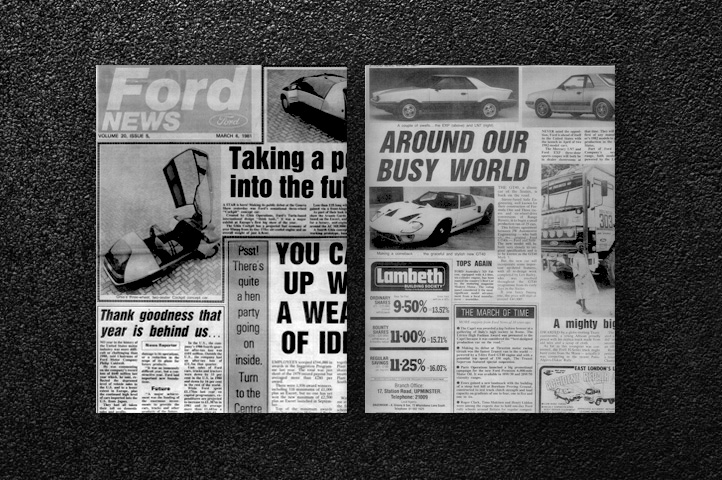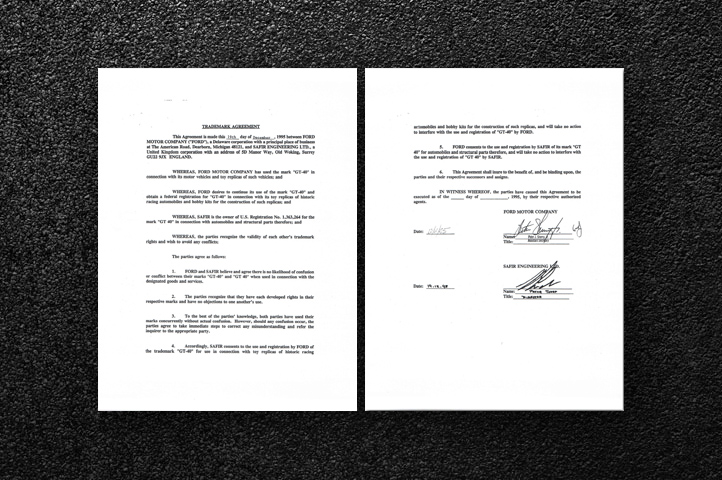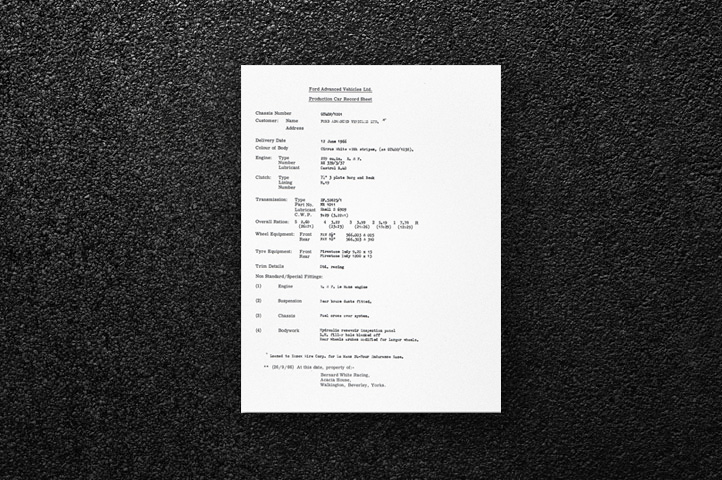
Safir Engineering Limited
Although there was considerable publicity in the past and especially when the GT40 Mark V was launched in 1981, this was over thirty years ago and for this reason I have been requested to compile the Mark V story for all the GT40 Owners, Enthusiasts and Motoring Media.
I hope you will find the following of interest and that it will serve as an official record for the least known GT40 Mark.
As a former Director of Safir, I was involved with all aspects of this GT40 Mark V program, from the initial conception to the final car built (number forty)
GT40 Mark V Beginning
I had searched for many years looking for a GT40 in good condition. Most of the cars had problems including the dreaded rust issue. My Company Safir Engineering were building and fielding Formula three race cars, in addition we purchased a Formula One from the Ron Dennis Company "Token Racing." Formula One events in which Safir Engineering competed included Brands Hatch and Silverstone. Safir was also redesigning Range Rovers modifying the unit to six wheel drive and exporting these to foreign markets. Safir technical capabilities were such that we could rebuild GT40s so it was with this in mind I approached John Willment for his thoughts. John was of the same mindset and our discussions were positive.
It was soon decided that there would be a limited further run of the significant GT40.
"JW Engineering would oversee the build and Safir was to do the work."
The continued JW Engineering/Safir Engineering production would utilize sequential serial numbers starting at the last used GT40 serial number and move forward. Maintaining the GT40 Mark nomenclature this continued production would be named GT40 Mark V. These cars would carry JW Engineering chassis plates identical to those on all the GT40s produced by JW Engineering.
JW Engineering wished to complete the GT40 chassis numbers GT40P-1087, 1088 and 1089. This was supposed to take place prior to the beginning of Safir production however the completion of these three chassis' was very much delayed.
GT40 Recap:
- Prototypes: The first serial numbers GT 101 forward to GT 112 were prototype Ford GTs.
- Mark I GT40 and Mark II GT40 production: started with serial number GT40P-1000 and went to GT40P-1086.
- Mark III production GT40s started at GT40P-1101 and continued through to GT40P-1114. Later in this series the cars were built as Mark I.
- Mark IV, built in America, the J Car utilized different numbers beginning at J-1.
- Mark V production GT40s started at GT40P-1090 to GT40P-1100, GT40P-1115 to GT40P-1125, GT40P-1128 to GT40P-1145. Total, forty cars.
Note: Initially the GT40 Mark V production was to be 25 cars. This subsequently changed to 40 cars.
The first GT40 Mark V was delivered April 1981, thirty nine cars delivered by September 1994. The last and fortieth car delivered September 2000.
GT40 Mark V Build
Len Bailey was hired to inspect the proposed build and engineer any changes he thought prudent to ensure the car was safe as well as minimize problems experienced in the past. Len changed the front suspension to Alan Mann specifications which minimized nose dive under braking. Zinc coated steel replaced the previous uncoated rust prone sheet metal. The vulnerable drive doughnuts were replaced with CV joints and the leak prone rubber gas tanks were replaced with aluminium tanks. The GT40 chassis was upgraded without making any major changes.
Tennant Panels supplied the roof structure and the balance of the chassis was completed by Safir. JW Engineering ex-employees were used where-ever possible. Bill Pink noted for his electrical experience and the wiring installation of previous GT40 automobiles was brought in. Also Jim Rose was employed for his experienced with working at both Alan Mann and Shelby. After Chassis 1120 John Etheridge ex-Ford Advanced Vehicles was contracted to manage the GT40 build. Base chassis was supplied from Adams McCall Engineering and roof structure supplied by Tennant panels.
For the most part, the Mark V resembled very closely the Mark I car although there were a few changes and as with the 60s production very few cars were identical.
One customer had damaged a foot from motorcycle racing and required vacuum assisted braking.
A few customers wished to have more control in the build so received the cars less engine.
The first car GT40P-1090 had an open top in place of roofed doors.
Most motors were Ford small block, Webers or 4 Barrel Carburetor.
Safir produced five Big Block GT40s, serial numbers GT40P-1128 to GT40P-1132.
These aluminium big block cars all had easily removable door roof sections.
Most GT40s were high performance street cars however some of the Mark V production can be described as full race specification.
Two road cars GT40P-1133 (roadster) and GT40P-1142 (roofed doors) were built as lightweights which included an aluminium honeycomb chassis and very light carbonfiber bodywork.
Complete files on each of these forty cars have been forwarded to authors and journalists known for maintaining accurate records on the GT40 automobile.
-
Mark V weight according to the build type.
• 862 Kg for the lightweight aluminium chassis and carbon fiber body.
• 939 Kg for the race cars, steel chassis and carbon fiber body.
• 994 Kg for the small block road cars, steel chassis and carbon fiber body.
• 1030 Kg for the big block road cars, steel chassis, carbon fiber body.
• 1039 Kg for the small block road cars, steel chassis, fiberglass body.
John Wyer kept in touch, visiting the shop and attending a 1985 Mark V test session at Goodwood. We were happy to hear Mr. Wyer comments that the Mark V was exactly as he would have done.
"I have stated that there will be no more GT40 Mark Vs constructed; I have the assurance from the three partners of Safir GT40 Spares that no new Mark Vs will be constructed.
Ford Motor Company re the GT40 Mark V
With the completion of GT40P-1090, the Mark V caught Fords attention.
After their careful inspection of the Mark V we received communication from the Ford Motor Company. There would be no financial support however Ford was in favour of the Mark V and would be of assistance in some areas.
Ford/JW ex-employees Len Bailey, J. Etheridge, Bill Pink, and Jim Rose were utilized to realize this next variant on the GT40 Mark. Brian Wingfield of Ford and Brian Angliss of AC Cars were also helpful.
Ford arranged to have one of their UK road compliance experts assist JW Engineering and Safir Engineering steer through the complex issue of certification. Ford/Safir met with the compliance enforcement office in the town of Bristol. This attempt to work with government officials on GT40 road compliance cannot be described as a great success.
March 6, 1981, The Ford Company Newspaper "Ford News" Volume 20, Issue 5, covered the "graceful and stylish new GT40". This article also confirmed the agreement between JW Engineering, Ford and Safir, to build the GT40 Mark V.
Soon after, Walter Hayes Vice President Ford Motor Company travelled to the Safir Engineering Brooklands Workshop for a meeting with myself and John Willment re discussions regarding the GT40 Mark V. Interesting to note that Walter Hayes company car was a GT40 Mark III. (Serial number GT40P-1107)
Walter Hayes, involved with the GT40 program from the very beginning was excited about the project but concerned about Ford liability.
Walter Hayes felt there would be too close of a connection if the GT40 Mark V was named "Ford GT40 Mark V".
JW Engineering /Safir and Ford agreed and the Mark V GT40 would be described as "GT40 Mark V Powered by Ford", thus reducing legal liability to the Ford Motor Company. Mark V production went well and not much was heard from Ford until 1995, some 14 years later.

How did Safir Engineering obtain the GT40 Trademark.
Low quality kit cars dragging down the integrity of the GT40 name began to be far too familiar.
JW Engineering helped protect the name to some extent but Ford was very slow to directly help in protecting the GT40 name. Again maintaining a distance due to potential liability. Safir stated that if help was not forthcoming, Safir would trademark GT40 to protect the name. Both Ford and JW Engineering had no issue with Safir Engineering bearing the cost to register and protect the GT40 name.
Safir applied for and received the trademark for GT40 in 1985.
Ford approached Safir Engineering in 1995 stating Ford Co. was being contacted by toy model manufacturers asking for permission to produce GT40 model toy cars. Ford did not own the GT40 rights and was not in a position to approve the toy production.
Safir gave to Ford, for no charge, the GT40 name, for production of toy replicas of historic racing automobiles and hobby kits.
In turn, Ford confirmed they consent to the use and registration by Safir of their Mark GT40 for automobiles and structural parts therefore, and will take no action to interfere with the use and registration by Safir.
This agreement was signed by myself, Director of Safir Engineering and the Assistant Secretary, Ford Motor Company, December 19, 1995.

Are the cars GT40s?
One of the facts about GT40 production is the accuracy and maintenance of records. This includes the Mark I, this includes the Mark II, this includes the Mark III, This includes the Mark IV, and this includes the Mark V.
Each chassis has a recorded history starting with the factory build sheet.
Each factory build sheet describes the manufacturer, the chassis identity, details of the vehicles build including upholstery, power train and often the gear ratios. The customer for each chassis produced is recorded including the date of delivery.
The first build sheets GT40P-1000 forward are Titled "Ford Advanced Vehicles" and all chassis are recorded as GT40.
Build sheets from January 1, 1967 forward are titled "JW Engineering" and all chassis are recorded as GT40.
Ford Advanced Vehicles Ltd.
Production Car Record Sheet
Chassis Number GT40P-1001
Delivery Date June 12, 1966.
This record goes on to describe many details of the build, Color, Engine number, lubricant, clutch, Transmission, gear ratios, wheel information, tyre information, trim, engine tune, suspension, fuel cross over system, bodywork details such as one or two fuel fill holes and size of rear wheel arch.
Then the owner. 26/9/66 At this date, property of: Bernard White Racing, Acacia House, Walkington, Beverly, Yorks.
The records show, cars produced forward from serial number GT40P-1000 are GT40s.
Example: Production record of GT40P 1001 and GT40P 1090.

GT40P/1001
View View the Ford Advanced Vehicles production sheet for chassis GT40P/1001.
view production sheet
The Mark V cars today.
Marks V's are mainly in the UK and the USA but can be found in very many countries around the world.
There has been one car involved in a major accident requiring a new chassis. The damaged chassis was cut in two from front to back which keeps the Mark V GT40 chassis to a level of forty.
Myself as well as the Directors of Safir GT40 Spares maintain contact with these Owners and update the registry should a Mark V change owners. I am happy to note, many Mark Vs are still with their original buyer.
The GT40 is a wonderful car designed in the wild 1960 days of motorsport. The sophisticated design of this car was years ahead of its time, its raw power required a capable driver at the best of times yet there was a passenger seat. Hard to imagine the Lemans winning GT40 automobile was available for use on public roadways.
Best Regards

Peter Thorp
Former Managing Director
Safir Engineering
Woking, Surrey, UK